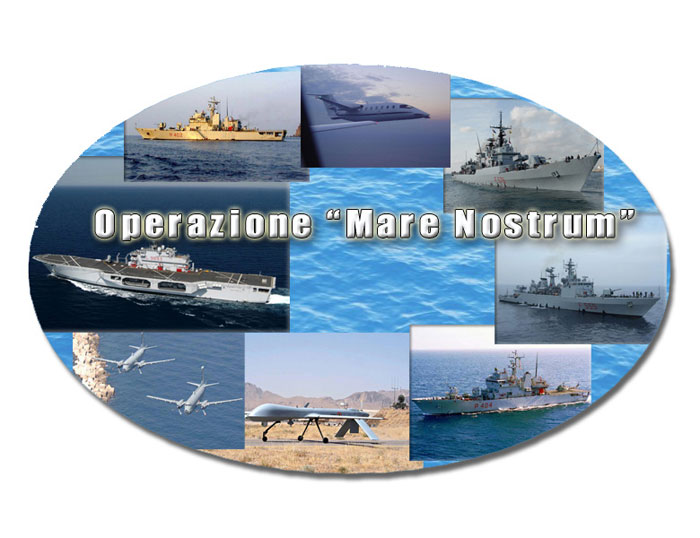The Mare Nostrum Operation was launched by the Italian Government on
18 October 2013, as a military and humanitarian operation aimed at tackling the
humanitarian emergency in the
Strait of Sicily, due to the dramatic increase in
migration flows. The Operation ended on
31 October 2014, coinciding with the start of the new operation called
Triton.
This Operation was an
upgrade of the force for monitoring migration flows already operating within the
operation Constant Vigilance, which the Italian Navy has been conducting since dal 2004, permanently deploying a ship in the Strait of Sicily along with maritime patrol aircraft.
Operation Mare Nostrum had therefore the twofold purpose of
•
safeguarding human life at sea, and
•
bringing to justice human traffickers and migrant smugglers.
The Force included personnel as well as sea and air assets of the Navy, Air Force, Carabinieri, Financial Police, Harbour Masters Corps / Coast Guard, personnel of the Italian Red Cross military corps and of the Ministry of the Interior / State Police, embarked on Italian Navy vessels, with the contribution of all the governmental agencies involved in controlling migration flows by sea.
In particular, the Italian Navy deployed:
• 700 to 1,000 personnel;
• 1 LPD amphibious vessel with specific command and control functions, equipped with advanced medical facilities for Role 1 care, including a shelter and a biocontainment pod, The ship can also carry landing craft and Rigid Hull Inflatable Boats (RHIB), and is able to receive onboard representatives of other Ministries or national/international organisations involved in the operation;
• 2 Minerva Class corvettes;
• 2 Costellazioni/Comandanti Class patrol vessels, each providing 1 SH- 212 helicopter, one of which in the fisheries surveillance role;
• 1 medium-to-heavy SH90 (TRR) helicopter embarked onboard the amphibious vessel, along with 2 S-100 unmanned aerial vehicle (UAV);
• 1 EH 101 (MPH) helicopter, deployed ashore in Lampedusa
• 1 MM P180 aircraft and 1 PS P180 aircraft equipped with Forward Looking InfraRed - FLIR) cameras, deployed at Pratica di Mare;
• 1 LRMP Breguet Atlantic, deployed at Sigonella;
• 1 medium AW139 helicopter (Police Force) deployed at Lampedusa;
• 1 AW109
Light Utility Helicopter (Carabinieri) deployed at Lampedusa;
• Italian Navy coastal radar network and Automatic Identification System (AIS).
The sea and air force was under the command of an Admiral embarked on a flagship serving as command and control platform. Such unit also embarked personnel of the Public Security Department – Central Directorate for Immigration, and Border Police, which effectively contributed to the improvement of onboard migrant identification procedures. On all vessels, medical checks were carried out by the shipboard medical staff, assisted by doctors of the Sea and Air Border Health Department (ISMAF), personnel of the Military Corps and Voluntary Nurses of the Italian Red Cross, along with voluntary medical personnel of the
Order of Malta's Italian Relief Corps
(CISOM) and
Francesca RAVA
Foundation
Operation Mare Nostrum operated concurrently with Frontex planned activities:
• Frontex is a European Union institution aimed at coordinating the monitoring and control of the sea, land and air external borders of EU member States, as well as implementing readmission agreements with neighbouring countries concerning non-EU migrants rejected at the borders.
•
Eurosur is the new European sea and land border surveillance system, mainly based on the use of drones.
Follow
#MareNostrum news on Twitter:
@ItalianNavy
